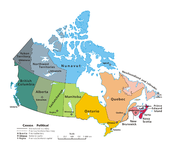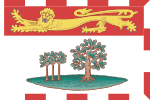
List of Canadian provinces and territories by population
Encyclopedia

This is a list of Canadian provinces and territories by population, based on Statistics Canada
Statistics Canada
Statistics Canada is the Canadian federal government agency commissioned with producing statistics to help better understand Canada, its population, resources, economy, society, and culture. Its headquarters is in Ottawa....
estimates as of July 1, 2011.
Canada
Canada
Canada is a North American country consisting of ten provinces and three territories. Located in the northern part of the continent, it extends from the Atlantic Ocean in the east to the Pacific Ocean in the west, and northward into the Arctic Ocean...
has ten provinces and three territories
Provinces and territories of Canada
The provinces and territories of Canada combine to make up the world's second-largest country by area. There are ten provinces and three territories...
. The three territories of Nunavut
Nunavut
Nunavut is the largest and newest federal territory of Canada; it was separated officially from the Northwest Territories on April 1, 1999, via the Nunavut Act and the Nunavut Land Claims Agreement Act, though the actual boundaries had been established in 1993...
, Yukon
Yukon
Yukon is the westernmost and smallest of Canada's three federal territories. It was named after the Yukon River. The word Yukon means "Great River" in Gwich’in....
, and Northwest Territories
Northwest Territories
The Northwest Territories is a federal territory of Canada.Located in northern Canada, the territory borders Canada's two other territories, Yukon to the west and Nunavut to the east, and three provinces: British Columbia to the southwest, and Alberta and Saskatchewan to the south...
account for over a third of Canada's area but have very few people, negatively skewing the national population density
Population density
Population density is a measurement of population per unit area or unit volume. It is frequently applied to living organisms, and particularly to humans...
value. Canada's population is concentrated in the areas close to the U.S. border. As a result, most Canadians live in areas with densities higher than the national average
Average
In mathematics, an average, or central tendency of a data set is a measure of the "middle" value of the data set. Average is one form of central tendency. Not all central tendencies should be considered definitions of average....
of 3.731 persons per square kilometre.
All territories and provinces excluding the Northwest Territories
Northwest Territories
The Northwest Territories is a federal territory of Canada.Located in northern Canada, the territory borders Canada's two other territories, Yukon to the west and Nunavut to the east, and three provinces: British Columbia to the southwest, and Alberta and Saskatchewan to the south...
increased in population from January 2008 to January 2009. In terms of percentage change, the fastest-growing province or territory was Alberta
Alberta
Alberta is a province of Canada. It had an estimated population of 3.7 million in 2010 making it the most populous of Canada's three prairie provinces...
with an increase of 2.56% from January 2008 to January 2009, followed by Yukon
Yukon
Yukon is the westernmost and smallest of Canada's three federal territories. It was named after the Yukon River. The word Yukon means "Great River" in Gwich’in....
with 2.09% growth. The only province or territory shrinking in population was the Northwest Territories
Northwest Territories
The Northwest Territories is a federal territory of Canada.Located in northern Canada, the territory borders Canada's two other territories, Yukon to the west and Nunavut to the east, and three provinces: British Columbia to the southwest, and Alberta and Saskatchewan to the south...
with a loss of 1.14% from January 2008 to January 2009. These different rates of change are caused by birth
Birth rate
Crude birth rate is the nativity or childbirths per 1,000 people per year . Another word used interchangeably with "birth rate" is "natality". When the crude birth rate is subtracted from the crude death rate, it reveals the rate of natural increase...
and death rates, as well as interprovincial migration
Human migration
Human migration is physical movement by humans from one area to another, sometimes over long distances or in large groups. Historically this movement was nomadic, often causing significant conflict with the indigenous population and their displacement or cultural assimilation. Only a few nomadic...
and immigration
Immigration
Immigration is the act of foreigners passing or coming into a country for the purpose of permanent residence...
from outside Canada. As a whole, Canada's population grew by 1.21% from January 2008 to January 2009. Canada's population has increased every year since Confederation
Canadian Confederation
Canadian Confederation was the process by which the federal Dominion of Canada was formed on July 1, 1867. On that day, three British colonies were formed into four Canadian provinces...
in 1867 (see List of population of Canada by years).
Listing
| Rank | Name and flag | Abbreviation | Population (2011) |
Percentage of national pop. | Land area (km²) | Population density (/km2) | Seats in House of Commons Canadian House of Commons The House of Commons of Canada is a component of the Parliament of Canada, along with the Sovereign and the Senate. The House of Commons is a democratically elected body, consisting of 308 members known as Members of Parliament... |
Percentage of Seats in House of Commons Canadian House of Commons The House of Commons of Canada is a component of the Parliament of Canada, along with the Sovereign and the Senate. The House of Commons is a democratically elected body, consisting of 308 members known as Members of Parliament... |
|---|---|---|---|---|---|---|---|---|
| 1 |  Ontario OntarioOntario Ontario is a province of Canada, located in east-central Canada. It is Canada's most populous province and second largest in total area. It is home to the nation's most populous city, Toronto, and the nation's capital, Ottawa.... |
ON | 13,372,996 | 38.8% | 967,741 | 13.82 | 106 | 34.4% |
| 2 |  Quebec QuebecQuebec Quebec or is a province in east-central Canada. It is the only Canadian province with a predominantly French-speaking population and the only one whose sole official language is French at the provincial level.... |
QC | 7,979,663 | 23.1% | 1,365,128 | 5.85 | 75 | 24.4% |
| 3 |  British Columbia British ColumbiaBritish Columbia British Columbia is the westernmost of Canada's provinces and is known for its natural beauty, as reflected in its Latin motto, Splendor sine occasu . Its name was chosen by Queen Victoria in 1858... |
BC | 4,573,321 | 13.3% | 925,186 | 4.94 | 36 | 11.7% |
| 4 |  Alberta AlbertaAlberta Alberta is a province of Canada. It had an estimated population of 3.7 million in 2010 making it the most populous of Canada's three prairie provinces... |
AB | 3,779,353 | 11.0% | 642,317 | 5.88 | 28 | 9.1% |
| 5 |  Manitoba ManitobaManitoba Manitoba is a Canadian prairie province with an area of . The province has over 110,000 lakes and has a largely continental climate because of its flat topography. Agriculture, mostly concentrated in the fertile southern and western parts of the province, is vital to the province's economy; other... |
MB | 1,250,574 | 3.6% | 553,556 | 2.26 | 14 | 4.5% |
|- align="center"
| 6
| align="left" |
 Saskatchewan
SaskatchewanSaskatchewan
Saskatchewan is a prairie province in Canada, which has an area of . Saskatchewan is bordered on the west by Alberta, on the north by the Northwest Territories, on the east by Manitoba, and on the south by the U.S. states of Montana and North Dakota....
| SK
| align="right" | 1,057,884
| 3.1%
| align="right" | 591,670
| 1.79
| 14
| 4.5%
|- align="center"
| 7
| align="left" |
 Nova Scotia
Nova ScotiaNova Scotia
Nova Scotia is one of Canada's three Maritime provinces and is the most populous province in Atlantic Canada. The name of the province is Latin for "New Scotland," but "Nova Scotia" is the recognized, English-language name of the province. The provincial capital is Halifax. Nova Scotia is the...
| NS
| align="right" | 945,437
| 2.7%
| align="right" | 53,338
| 17.73
| 11
| 3.6%
|- align="center"
| 8
| align="left" |
 New Brunswick
New BrunswickNew Brunswick
New Brunswick is one of Canada's three Maritime provinces and is the only province in the federation that is constitutionally bilingual . The provincial capital is Fredericton and Saint John is the most populous city. Greater Moncton is the largest Census Metropolitan Area...
| NB
| align="right" | 755,455
| 2.2%
| align="right" | 71,450
| 10.57
| 10
| 3.2%
|- align="center"
| 9
| align="left" nowrap |
 Newfoundland and Labrador
Newfoundland and LabradorNewfoundland and Labrador
Newfoundland and Labrador is the easternmost province of Canada. Situated in the country's Atlantic region, it incorporates the island of Newfoundland and mainland Labrador with a combined area of . As of April 2011, the province's estimated population is 508,400...
| NL
| align="right" | 510,578
| 1.4%
| align="right" | 373,872
| 1.37
| 7
| 2.3%
|- align="center"
| 10
| align="left" |
 Prince Edward Island
Prince Edward IslandPrince Edward Island
Prince Edward Island is a Canadian province consisting of an island of the same name, as well as other islands. The maritime province is the smallest in the nation in both land area and population...
| PE
| align="right" | 145,855
| 0.4%
| align="right" | 5,660
| 25.77
| 4
| 1.3%
|- align="center"
| 11
| align="left" |
 Northwest Territories
Northwest TerritoriesNorthwest Territories
The Northwest Territories is a federal territory of Canada.Located in northern Canada, the territory borders Canada's two other territories, Yukon to the west and Nunavut to the east, and three provinces: British Columbia to the southwest, and Alberta and Saskatchewan to the south...
| NT
| align="right" | 43,675
| 0.1%
| align="right" | 1,183,085
| 0.037
| 1
| 0.3%
|- align="center"
| 12
| align="left" |
 Yukon
YukonYukon
Yukon is the westernmost and smallest of Canada's three federal territories. It was named after the Yukon River. The word Yukon means "Great River" in Gwich’in....
| YT
| align="right" | 34,666
| 0.1%
| align="right" | 474,391
| 0.073
| 1
| 0.3%
|- align="center"
| 13
| align="left" |
 Nunavut
NunavutNunavut
Nunavut is the largest and newest federal territory of Canada; it was separated officially from the Northwest Territories on April 1, 1999, via the Nunavut Act and the Nunavut Land Claims Agreement Act, though the actual boundaries had been established in 1993...
| NU
| align="right" | 33,322
| 0.1%
| align="right" | 1,936,113
| 0.017
| 1
| 0.3%
|- class="sortbottom" bgcolor="yellow" align="center"
|bgcolor="yellow"| Total
|bgcolor="yellow" align="left"|
 Canada
CanadaCanada
Canada is a North American country consisting of ten provinces and three territories. Located in the northern part of the continent, it extends from the Atlantic Ocean in the east to the Pacific Ocean in the west, and northward into the Arctic Ocean...
|bgcolor="yellow"|
|bgcolor="yellow" align="right"| 34,482,779
|bgcolor="yellow"|100%
|bgcolor="yellow" align="right"| 9,093,507
|bgcolor="yellow"| 3.792
|bgcolor="yellow"| 308
|bgcolor="yellow"| 100%
|}

